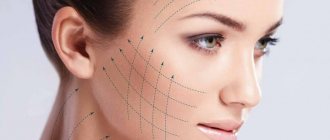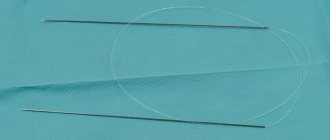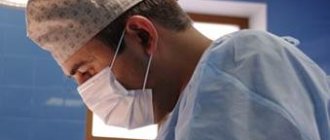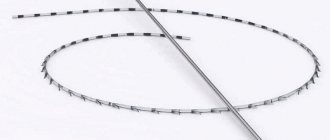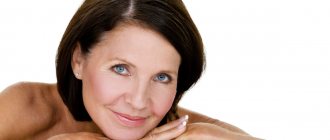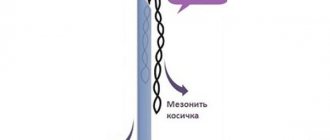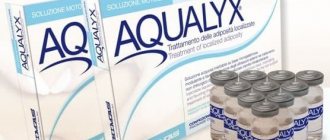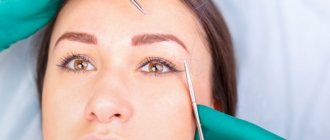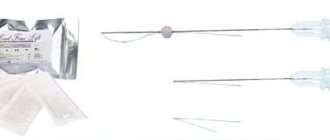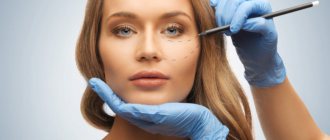Threads for face lifting of the old generation - when you don’t need gold for nothing
Until 2010, aesthetic medicine clinics used a different type of thread. These were gold threads, inserted under the skin permanently, and synthetic ones - first solid, then absorbable, thick and long, with hooks.
Only 2-3 threads were inserted into the cheek, which were supposed to lift the tissue. After treatment, the first effect was good. Problems arose over time. With the constant introduction of threads, it is necessary to take into account that the position of the face changes with age. The location of the skin, bones, and subcutaneous tissue shifts, and the threads suddenly find themselves in a place different from where they should be from an aesthetic point of view.
In addition, such tightening threads often “protrude through the skin.” It's a bit like a tent frame. It holds the shape of the tent and stretches it, but underneath the fabric you can see the hard contours. There was a similar problem with permanent fillers, which aesthetic medicine has almost completely moved away from, but women are still struggling with the unpleasant results left over from those times.
Old generation gold threads for facelift
To summarize, the old generation threads basically stretched the skin, but underneath it was... empty.
Types of threads
Classification by materials
Initially, materials that were not subject to biological degradation were used for ligature skin lifting. Next, threads were created that could completely disappear in tissues in a period of 6 months - this time is enough for new connective tissue to form and a collagen frame to form.
Non-absorbable threads
These threads are very thin and have increased density characteristics.
They are fixed in soft tissues in accordance with the anatomical structure of the face, and the inertness of the materials from which the threads are made reduces the incidence of allergic reactions or rejection to almost zero.
At the moment, the following types of non-absorbable threads exist on the cosmetic services market:
- gold or platinum
Essentially, they are a wire up to 0.1 mm thick around a polymer base, which dissolves over time, leaving a precious spiral under the skin.
They are used relatively rarely due to the high cost of the material, as well as due to a number of disadvantages: the impossibility of using hardware cosmetology, as well as “transillumination” at a certain angle and lighting.
- medical polypropylene
Wear-resistant and durable material that is well retained in the subcutaneous fat layer. Over time, the structure of such threads has been modified to achieve the best effect. When silicone is added to the composition, special threads are obtained - tissulift . The frame created by such combined threads is elastic and durable, and due to the depth of fixation, new support points for muscle tissue are actually created, preserving the mobility of facial expressions.
- Teflon
Rarely used material due to the long recovery period after the procedure.
Non-absorbable threads are immersed deep into the muscle layer, which is why these procedures are more painful and have a higher incidence of complications. But the effect of the procedure is long-lasting and clearly visible, so it is recommended for patients over 50 years of age.
Absorbable threads
Biodegradable threads are attached to the surface layers of the skin and dissolve on average in 6-12 months, and the collagen framework formed during this time is effective up to 2-3 years after the disappearance of the threads, so this procedure is more suitable for people aged 30-35 years. A facelift is carried out using the following materials:
- milk threads
Made from polylactic acid, an absorbable suture material that can lift the dermis and activate collagen production
- polydioxanone threads
Better known as 3D threads or mesothreads, they are a Korean invention, the thinnest existing threads, which are placed under the skin with the help of a specialized blunt-ended guide.
The peculiarity of the method is that the skin is not pierced with a needle, and the tissues are moved apart, which reduces injuries. The collagen rod coated with polydioxanone does not cause allergies, allows you to model the frame in all directions, and the effect lasts up to 2 years. The relatively low price of the material is also important.
Absorbable threads act, rather, as a prophylactic agent and fight only the initial signs of aging, and they can no longer eliminate pronounced sagging of the skin.
Liquid threads
An alternative method of bioplastics is the use of the so-called. “liquid” threads, which are a gel-like composition containing hyaluronic acid injected under the skin through a very sharp needle.
The threads hardened under the skin form a strong frame, and over the course of three years they are gradually removed from the body.
Classification by texture
Threads made from different materials may have different surfaces, each of which has its own characteristics, advantages and disadvantages.
- smooth
The first type of thread to appear, used in patients over the age of 45, is fixed deep under the skin with knots.
- with cones
The “youngest” development, which is preferred by most cosmetologists: along the entire length of the threads there are cones made of material that dissolves over time - this contributes to the best fixation in the tissues.
- with notches
On the surface of the threads there are peculiar “hooks” that cling to the tissue - different types of notches are required for different areas of the face. Such threads are introduced through micro-punctures to a depth of about 4 mm.
- spiral
Short threads that can return to their original state after stretching. They are not used independently, but are used on the most problematic areas for maximum modeling effect.
- "springs"
A very elastic and easily adaptable type of thread, used in the most mobile areas of the face.
Classification by mounting method
Threads for tightening are attached in two ways:
- fixed
They are attached using small incisions in inconspicuous places in the areas near the temples or ears. The effect of such threads is more pronounced, facial modeling is more active.
- autonomous
They are inserted in places chosen by a specialist, but cannot provide strong tension - their effect is to eliminate sagging and maintain elasticity.
New generation threads - a smart lifting philosophy
In the case of micron PDO threads used in the smart facelift, the treatment philosophy is completely different. This is not just stretching the skin (although sometimes too), but also using a large number of thin and short threads (5-10 cm) to intelligently create scaffolding so that the skin regenerates and becomes stiff in those places where it is needed.
New generation thread
Microns are safe because they are biocompatible, do not move and are absorbed. These are the same threads that are used in very precise operations, such as cardiac surgery or eye surgery. They are not suitable only for patients with autoimmune diseases, since if the body “overreacts” to the threads, there is no way to remove them and you have to wait until they dissolve. During this period, only conservative methods can be used for treatment.
The smart facelift uses both threads without hooks and threads with hooks (i.e. micro-grippers). The former are used to create a frame for the skin, the latter - to lightly tighten it. But they are not as aggressive as the old generation threads with hooks. This is especially useful if you want to lift your cheeks, but you can just as easily lift your bust and buttocks a bit.
Why does a cosmetologist need imagination - the result of tissue regeneration needs to be imagined
Smart lifting improves facial contour and strengthens tissue. It causes the skin to regenerate, making it thicker and tougher. If the subcutaneous tissue defects are so large that a smart facelift alone will not eliminate them, you can additionally supplement the treatment with polylactic acid or another filler.
The directions for inserting threads during a lift can be unidirectional or bidirectional. The threads are inserted with needles. During the procedure, the skin is, of course, pierced, but the patient does not feel it - the procedure is painless, since the area of skin where the thread will be inserted is first numbed.
The video and photos of the procedure show that many needles are inserted into the face. This is a surgical technique that allows you to see exactly where the threads were inserted (and how many). When everything is ready, the needles are pulled out one by one. Performing this procedure requires imagination, as one must anticipate how the patient's face will change after the insertion of absorbable sutures.
Thread lifting procedure
The main indications for the use of smart lifting are sagging skin, sagging “hamster” cheeks - microns with microhooks are useful here. Most procedures are performed on the face, but a smart facelift can be used on any part of the body, such as sagging breasts, buttocks, aging arms. PDO threads are also used in aesthetic gynecology.
For the treatment to have a noticeable effect, a few threads are not enough. The best facelift results can be obtained by using 30-40 threads. The threads are completely absorbed after about a year, but the effect of regenerated skin can last up to several years.
Lifting with PDO threads before and after. Photo 1
Lifting with PDO threads before and after. Photo 2
What are PDO threads used for?
Modern cosmetology has many means that can slow down the aging process. The procedure for introducing PDO mesothreads under the skin stands out.
Sonya Oganesyan
Cosmetologist, specialist in the field of hardware cosmetology
Ask a Question
Polydioxanone threads are a new approach to skin rejuvenation, improving its appearance and correcting some cosmetic defects. Its use is simple and safe. Polydioxanone has proven itself in surgery, where it has been successfully used for tissue suturing for a long time.
Why do you need polydioxanone mesothreads?
PDO threads perfectly solve the problems of wrinkles and pronounced folds, as well as sagging skin of the face and body as a result of age-related, traumatic and other changes.
Cosmetologists usually recommend resorting to this procedure after 28-30 years.
Lifting with PDO mesothreads is carried out using local anesthesia and lasts about an hour. The threads are inserted under the skin using an ultra-thin needle, the use of which leaves no marks. The effect is visible immediately after the procedure; it improves in the first 30-60 days and even after the active substance is absorbed, it persists for several months.
Polydioxanone mesothreads are completely absorbed in the body within 6-8 months after administration, without having a negative effect on it. In addition, they have high elasticity, which reduces the risk of a negative reaction to implantation.
Contraindications to the use of pdo threads are:
- acute infectious, autoimmune and oncological diseases,
- psychological and neurotic disorders,
- inflammation of the skin at the injection site,
- some blood diseases,
- tendency to form scars.
In addition, the procedure is not performed during pregnancy and lactation.
Special offer
Mono thread
295 rub.
490 rub.
Make an appointment
Possible complications after the introduction of polydioxanone mesothreads
The following complications may occur due to inaccurate insertion of threads:
- bruises and hematomas (stay on the face for more than 2 weeks);
- bumps on the skin;
- facial asymmetry;
- the thread stands out under the skin, remaining visible.
Contact good specialists to avoid such problems.
Recommended Procedures
Thread lifting
Contour plastic
TCA peeling
Cosmetic procedures are contraindicated during pregnancy and lactation.
Indications for the installation of pdo-threads: lifting the upper or lower part of the face, eliminating wrinkles in the eye area, chin, forehead, lifting the “double” chin.
Threads will not help remove stretch marks!
Patients often ask if threads are effective against stretch marks because they have met doctors who promote such treatments. Not really! Stretch marks are loss of tissue in the skin. To eliminate them, it is necessary to severely traumatize the tissue, for example, using the radiofrequency method, in order to speed up its regeneration.
Thus, inserting several threads will not do anything, because they are very thin, almost like hair. And inserting more PDO threads based on the principle of filling the volume does not pay off from a financial point of view. Each stretch requires at least 20 threads, and stretch marks on the body are not isolated.
Therefore, you need to use lifting threads where they can really help, and not as a panacea for everything that, unfortunately, begins to happen. Nothing better than RF microneedles has yet been invented to combat stretch marks.
